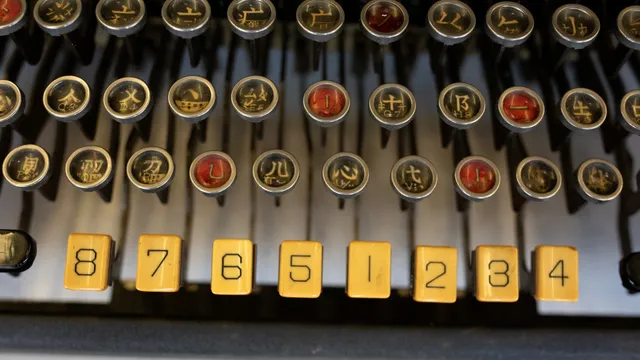
MingKwai typewriter discovery reveals origins of modern Chinese computing
2025-07-05 00:00- A long-lost typewriter, the MingKwai, was discovered in New York, pivotal to the development of Chinese computing.
- Lin Yutang created the MingKwai in the 1940s to address the complexity of typing Chinese characters.
- The discovery highlights the importance of cultural preservation in technological advancement.
Express your sentiment!
Insights
In recent months, a significant discovery was made in upstate New York when a long-lost typewriter surfaced, integral to the history of modern Chinese computing. This typewriter, known as the MingKwai, was developed by Lin Yutang, a prominent linguist and writer from southern China, in the 1940s. Lin aimed to create a device capable of efficiently typing Chinese characters, which are complex pictographs without a phonetic alphabet. Despite extensive research, the only prototype of the MingKwai was thought to be lost until Thomas Mullaney, a history professor at Stanford University, confirmed its recovery. Lin Yutang’s work exemplifies the challenges faced by scholars as they sought to merge technology with the intricacies of the Chinese language. With hundreds of dialects and no standardized phonetic system, the challenge of creating a functional typewriter was monumental. The MingKwai was designed to allow for input of up to 90,000 characters using an ergonomic keyboard that enabled users to find combinations of shapes representing different characters. This breakthrough not only impacted typing but also served as a precursor to modern computing technologies for Asian languages. The discovery of this typewriter has sparked renewed interest in linguistic research and the politics surrounding language technology in China, Taiwan, and beyond. Scholars are now discussing how Lin’s vision for an open, multicultural adaptation of Chinese culture intersected with the technological developments of his time. By recovering the MingKwai, researchers underscore the importance of cultural preservation in technological innovation, showing that cultural integrity and modernity can coexist. As Stanford University acquires and restores the typewriter, discussions have emerged about the implications for future technological advancements in language processing. Supporters of Lin's approach argue that his belief—that modernity does not require sacrificing one’s cultural heritage—is still relevant today. This case illustrates how historical technological innovations can inform current efforts to create inclusive and diverse computational methods for managing complex languages.
Contexts
Lin Yutang, a prominent Chinese author, philosopher, and inventor, is widely recognized for his contributions to the modern interpretation and understanding of Chinese culture and philosophy. His works, including 'The Importance of Living' and 'My Country and My People,' explored the essence of Chinese life through a Western lens, thereby bridging cultural divides. It is essential to note that while Yutang is celebrated for his literary accomplishments, he also played a pivotal role in the evolution of Chinese computing, particularly in the post-war era when technology and culture began to intermesh in unprecedented ways. His ideas on language, communication, and thought significantly influenced the development of computational linguistics, as his emphasis on the philosophy and beauty of the Chinese language inspired a new generation of thinkers and technologists. In the context of Chinese computing, Lin Yutang's approach to language and technology was revolutionary. He believed that the intricacies of Chinese characters and grammar offered a unique challenge to the development of computational systems. In his view, traditional Western computing methods were inadequate for processing the complexities of the Chinese language, which consists of thousands of characters that convey meanings through intricate strokes and compositions. Yutang's insights encouraged researchers to explore more innovative computing models that could accommodate this complexity, paving the way for the development of character recognition software and machine translation systems tailored for Chinese. His work continues to resonate in contemporary technology, particularly in fields such as natural language processing and artificial intelligence. As Chinese computing progressed through the late 20th century and into the 21st, the principles advocated by Lin Yutang began to materialize in practical applications. The advent of advanced algorithms capable of recognizing Chinese characters and facilitating communications across linguistic barriers bear testament to the foundational work laid by early thinkers like Yutang. The integration of cultural understanding into technological innovation has proven essential to the global proliferation of Chinese computing technologies. This interplay has not only influenced how computing tools are developed but has also enriched the technology landscape, fostering a more inclusive approach to software development that honors linguistic diversity. Lin Yutang’s legacy in the realm of Chinese computing exemplifies the ongoing dialogue between culture and technology. His vision of a world where language and machines coexist harmoniously has transcended his lifetime, inspiring current and future generations to consider the cultural ramifications of their technological endeavors. As the global community continues to embrace the interconnectedness brought on by digital innovations, the foundations laid by Lin Yutang serve as a reminder of the importance of cultural sensitivity in the design and implementation of computing systems. Such awareness not only enhances user experiences but also ensures that technology serves to promote understanding and appreciation across different cultures.